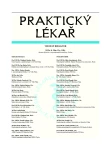Heart amyloidosis with a relatively benign course
Authors:
J. Čapek 1; M. Pěnička 1; M. Kment 2
Authors‘ workplace:
III. interní – kardiologická klinika 3. Lékařské fakulty a FN Královské Vinohrady, Praha
Přednosta: prof. MUDr. Petr Widimský, DrSc., FESC.
1; Pracoviště klinické a transplantační patologie, IKEM, Praha
Přednosta: MUDr. Eva Honsová, Ph. D.
2
Published in:
Prakt. Lék. 2009; 89(6): 320-323
Category:
Case Report
Overview
The authors present the case of an 81-year old patient with dyspnoea on exertion (NYHA II) and suspicion of coronary artery disease (CAD) due to graphically positive ergometry and detection of wide-complex tachycardia on Holter ECG. Apart from signs of chronic venous insufficiency on lower extremities, the physical examination was normal. The ECG recording showed sinus rhythm, 1st degree AV block and low voltage in limb leads. Signs of pulmonary congestion were found on a chest X-ray. Complex cardiology examination, including coronarography and echocardiography, disproved CAD. However, in regard to echocardiographic finding of possible restrictive cardiomyopathy, endomyocardial biopsy was performed and confirmed our suspicion of cardiac AL-amyloidosis. No amyloid was found in rectal biops. Serum and urine immunofixation were negative, trepanobiopsy disproved diagnosis of multiple myeloma and any other malignant plasma cell dyscrasia. Patient did not have signs of amyloidogenic involvement of other organs. On the grounds the examinations performed we concluded the case as isolated cardiac AL-amyloidosis. Isolated cardiac amyloidogenic involvement is rare (<5 % patients). Period from diagnosis assessment to specific haematology therapy administration, which should stabilize the disease, was in our case 9 months due to patient’s reserved approach. During this period the clinical state was stable, without deterioration of heart failure. Considering the median survival in untreated patients is < 6 months, we assess the course of the disease as relatively benign. Heart amyloidosis substantially worsens patient prognosis, which could be partially improved by early diagnosis and treatment.
Key words:
Heart amyloidosis, heart failure, echocardiography, endomyocardial biopsy.
Sources
1. Abraham, R.S., Geyer, S.M., Price-Troska, T.L., et al. Immunoglobulin light chain variable (V) region genes influence clinical presentation and outcome in light chain-associated amyloidosis (AL). Blood 2003, 101, p. 3801–3808.
2. Dubrey, S.W., Cha, K., Anderson, J. et al. The clinical features of immunoglobulin light-chain (AL) amyloidosis with heart involvement. QJM 1998, 91, p. 141-157.
3. Falk, R.H. Diagnosis and management of the cardiac amyloidoses. Circulation 2005, 112, p. 2047-2060.
4. Gertz, M.A., Comenzo, R., Falk, R.H. et al. Definition of organ involvement and treatment response in immunoglobulin light chain amyloidosis (AL): A consensus opinion from the 10th International Symposium on Amyloid and Amyloidosis. Am. J. Hematol. 2005, 79, p. 319–328.
5. Gertz, M.A., Lacy, M.Q., Dispenzieri, A. Amyloidosis: Recognition, confirmation, prognosis and therapy. Mayo Clin Proc. 1999, 74, p. 490-494.
6. Hamidi, A.K., Liepnieks, J.J., Nakamura, M. et al. Organspecific (localized) synthesis of Ig ligh chain amyloid. J. Immunol. 1999, 162, p. 5556-5560.
7. Hassan, W., Al-Sergani, H., Mourad, W. et al. Amyloid heart disease. New frontiers and insights in pathophysiology, diagnosis, and management. Tex. Heart Inst. J. 2005, 32, p. 178-184.
8. Kothari, S.S., Ramakrishnan, S., Bahl V.K. et al. Cardiac Amyloidosis –an update. Indian Heart J. 2004, 56, p. 197-203.
9. Krejčí, J. Srdeční amyloidóza. In: Veselka, J. a kol. Hypertrofická kardiomyopatie a příbuzná témata. Praha: Galén 2006, s. 141-148.
10. Maurer, M.S., Raina, A., Hesdorffer, Ch. et al. Cardiac transplantation using extended-donor criteria organs for systemic amyloidosis complicated by heart failure. Transplantation 2007, 83, p. 539-545.
11. Mikulová, A., Toušek, F., Šindelářová, Š. a kol. Progresivní srdeční selhání na podkladě srdeční amyloidózy. Prakt. Lék. 2007, 87, 10, s. 628-631.
12. Park, M.A., Mueller, P.S., Kyle, R.A. Primary (AL) hepatic amyloidosis: clinical features and natural history in 98 patients. Medicine 2003, 82, p. 291–298.
13. Ruberg, F.L., Appelbaum, E., Davidoff, R. et al. Diagnostic and prognostic utility of cardiovascular magnetic resonance imaging in light-chain cardiac amyloidosis. Am. J. Cardiol. 2009, 103, 4, p. 544-549.
14. Selvanayagam, J.B., Hawkins, P.N., Biju, P. et al. Evaluation and managment of the cardiac amyloidosis. J. Am. Coll. Cardiol 2007, 50, p. 2101-2110.
15. Shah, K.B., Inoue, Y., Mehra, M.R. Amyloidosis and the heart: a comprehensive review. Arch. Intern. Med. 2006, 166, p. 1805-1813.
16. Vogelsberg, H., Mahrholdt, H., Deluigi, C.C. et al. Cardiovascular magnetic resonance in clinically suspected cardiac amyloidosis: noninvasive imaging compared to endomyocardial biopsy. J. Am. Coll. Cardiol. 2008, 51, p. 1022-1030.
Labels
General practitioner for children and adolescents General practitioner for adultsArticle was published in
General Practitioner

2009 Issue 6
Most read in this issue
- Health problems related to drug abuse, possibility of prevention in primary care
- Errors in the treatment of delirium tremens
- Syndrome of combined pulmonary fibrosis and emphysema – CPFE syndrome
- Painful foot
